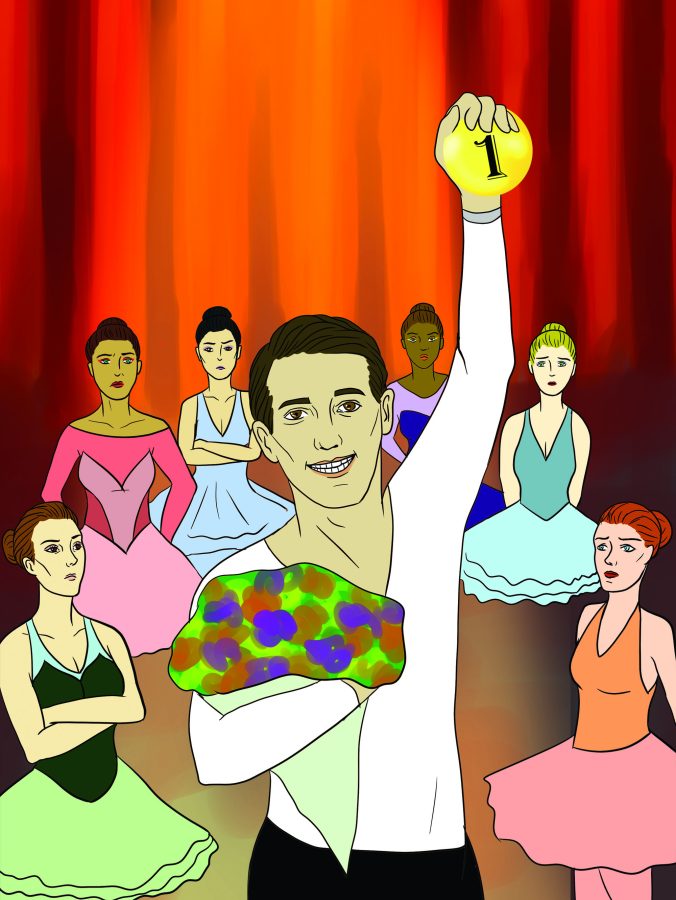Seniors Nathalia Castillo and Cayla Flagg do their hair, put on their leotards and cram their feet into their pointe shoes in preparation for one of their daily six-hour dance practices. The long dance classes are preparation for shows and competitions the two will partake in, which could potentially win them scholarships.
“For my dance studio we have two important shows,” said Castillo. “During the winter we perform the Nutcracker and during the spring we perform our spring showcase. In Paly Dance we have our performances from football and basketball halftimes, competitions and our end of the year showcase where we introduce our upcoming team for the next season.”
However, like many other female dancers, Castillo and Flagg’s busy schedules, filled with rehearsals and classes, are seemingly unrewarded. Regardless of the dedication these women put into their dances, they are always at a disadvantage. The judges often unfairly reward male dancers, solely based on the gender imbalance in competitions.
“Some judges do give boys higher scores because it’s unusual to see guys so it’s like giving them a boost of self-esteem to continue dancing because it’s something pretty unusual.”
Story continues below advertisementNathalia Castillo, Paly dance captain
This phenomenon is not seen only in the Bay Area –– it occurs frequently nation wide. Male dances have a higher chance of earning a dance scholarship, have a higher chance of placing better and have a higher chance of receiving more attention in dance class.
As unfair as this bias can be, the dance world is still challenging for the male dancers and some judges feel the need to give them a confidence boost. At the preschool level of dance, boys make up only 20 percent of the dance population. This percentage severely drops after age five, according to Principle Creative and Performing Arts.
Dance Moms, a hit reality TV show hosted on Lifetime, features pre-teen dancers and their mothers. These dancers, usually girls, compete in dance competitions every weekend and are well aware of the prejudice in the dance world.
“I’m nervous for [my daughter] Bryn to do a solo against [a boy],” said Dance Mom Ashlee Allen on the hit TV show Dance Moms. “[Because] it’s a boy, and I’ve even heard from the judges before they like when boys stay in dance. So they tend to give them a leg up.”
The phenomenon is not unknown to other dance moms and dancers.
“We call [the unfair points given to boys] penis points,” said former Dance Mom Melissa Zeigler.
The injustice does not discourage either Castillo or Flagg. They continue to compete and place in the competitions they attend.
“[Competitions are] really fun because we do secret sister gifts every competition so we get closer to all of our team and our coaches,” Castillo said. “And we get to go to Disneyland for Nationals. And we get to learn new choreography and perform them in front of lots of people so that’s really fun.”
Not only is it fun, but competitions are helpful to the dancers. At some competitions, the dancers receive critique and advice from the judges.
“I think it’s good to get input from the judges and it’s also a fun event to do with your dance friends,” Flagg said.
Debates about whether boys should be given an edge in the dance world continue and will probably continue to be made, but currently each competition and each studio decides what is best for their dancers. Castillo, similarly to many others, believes there is a middle ground.
“At some point I do [think it’s fair],” Castillo said. “When they are younger, it’s more understandable if they give them a higher scores that way they continue. But once you’re at the competitions that we’re doing, everyone has to be judged equally.”
Dance competitions will always be challenging, as hundreds of dancers compete, each hoping to win first. However, whether or not dance competitions are equal for everyone is still up for debate.

